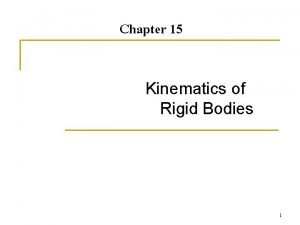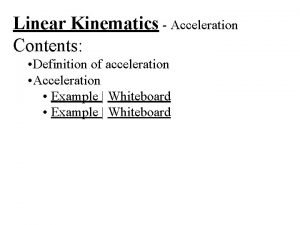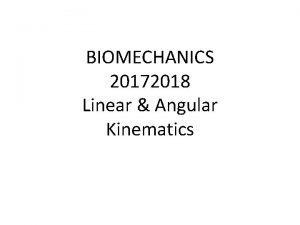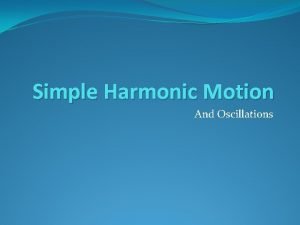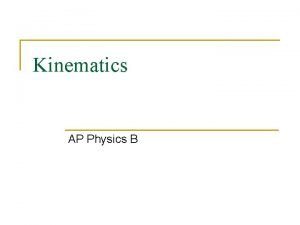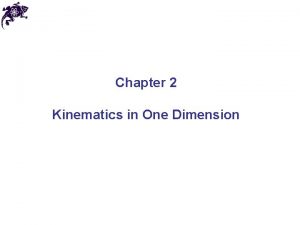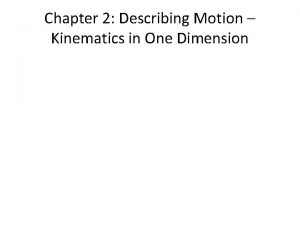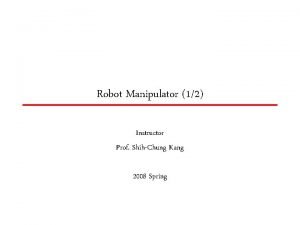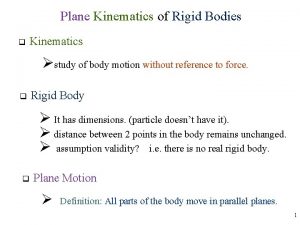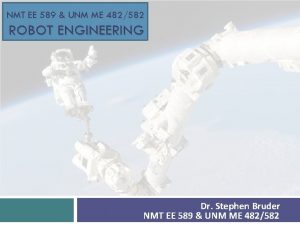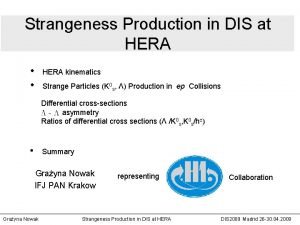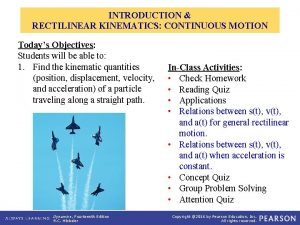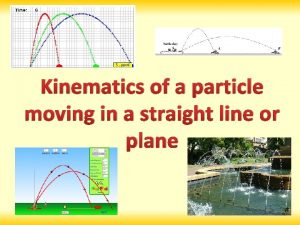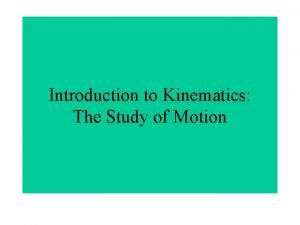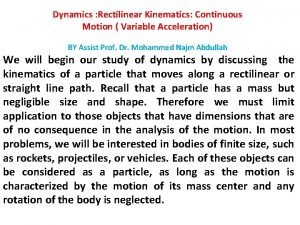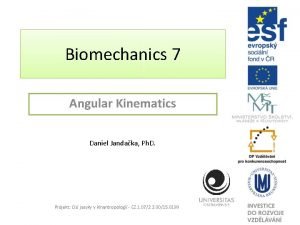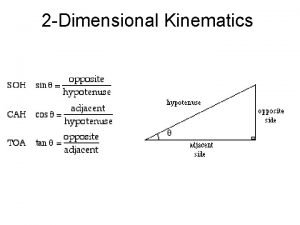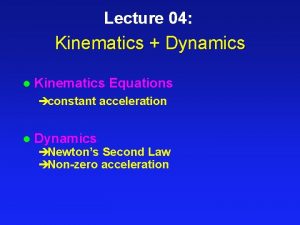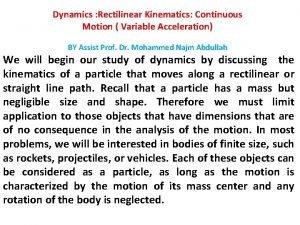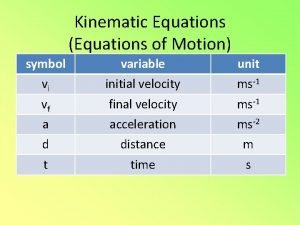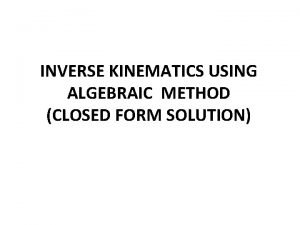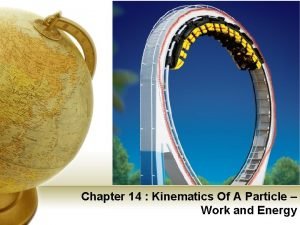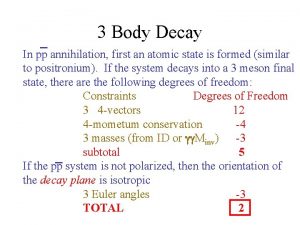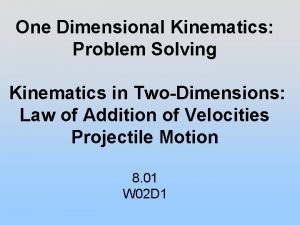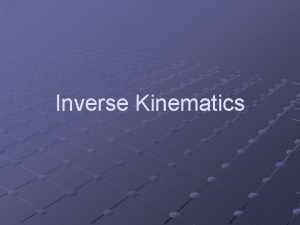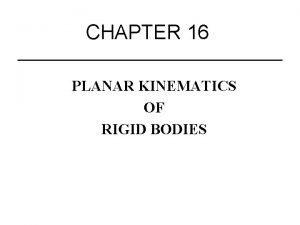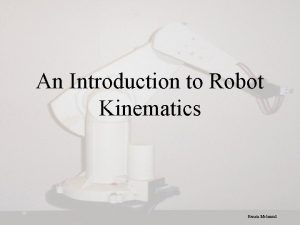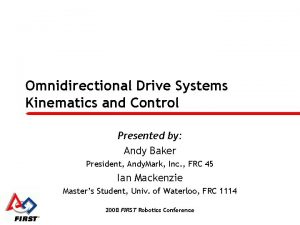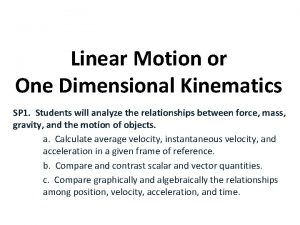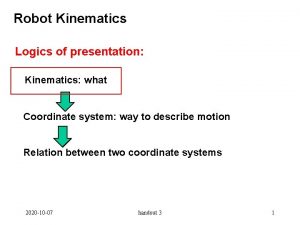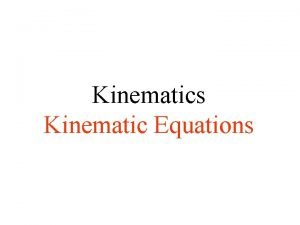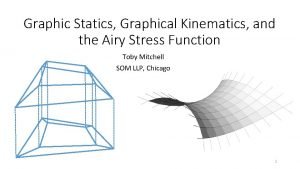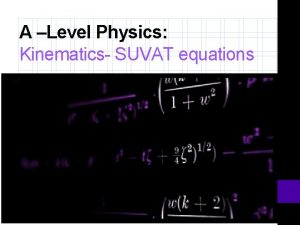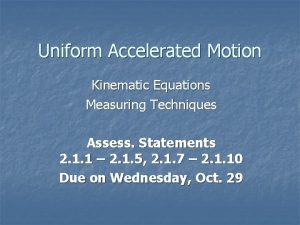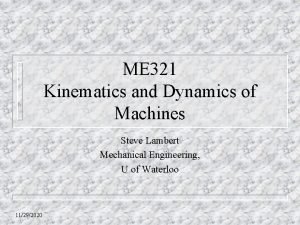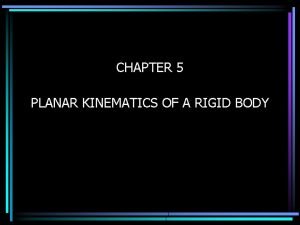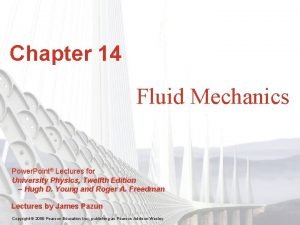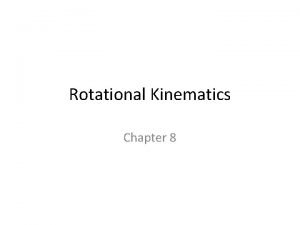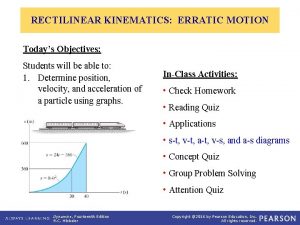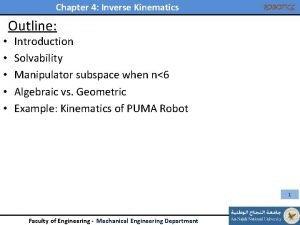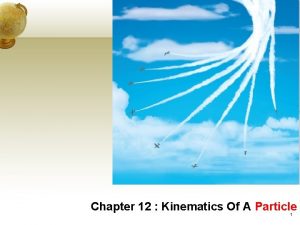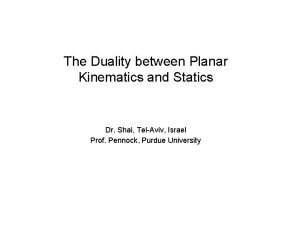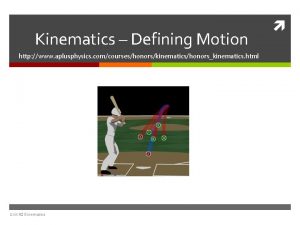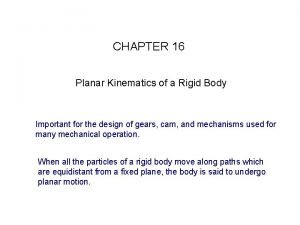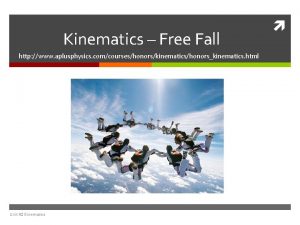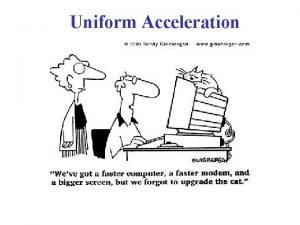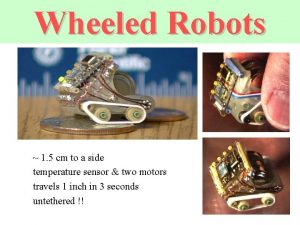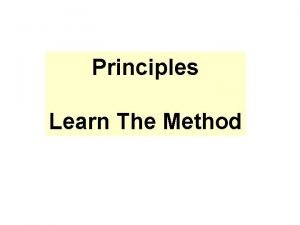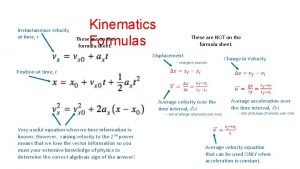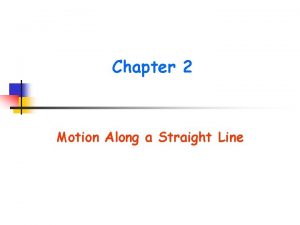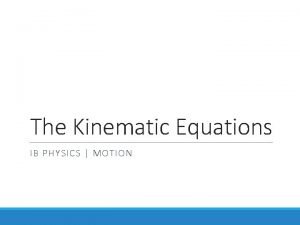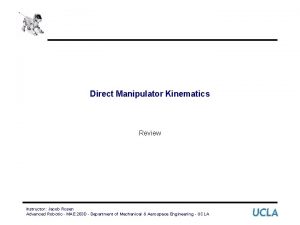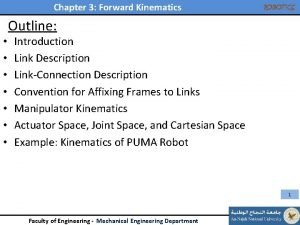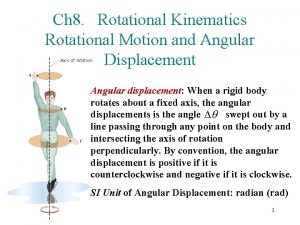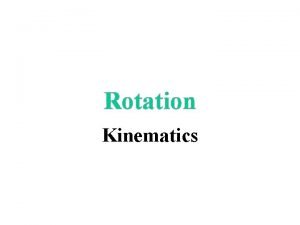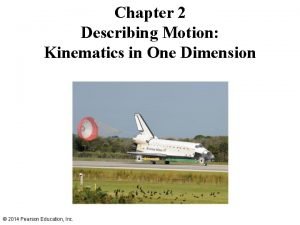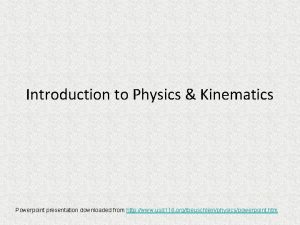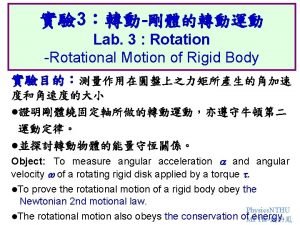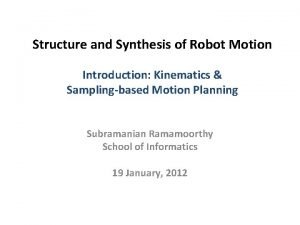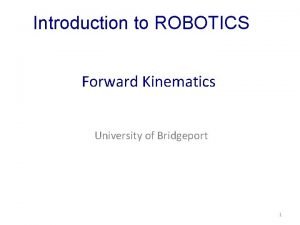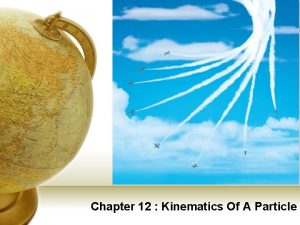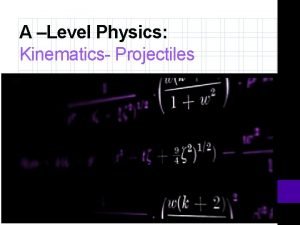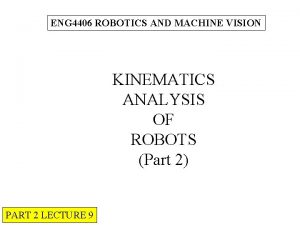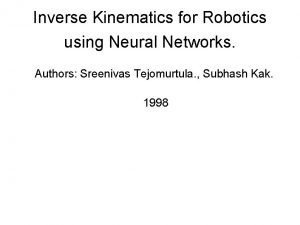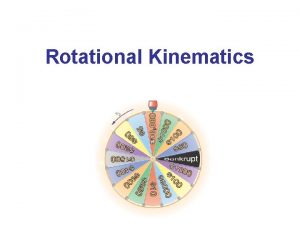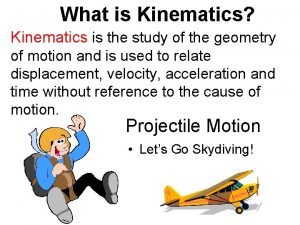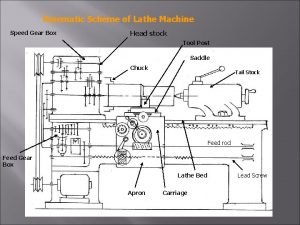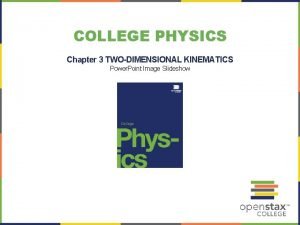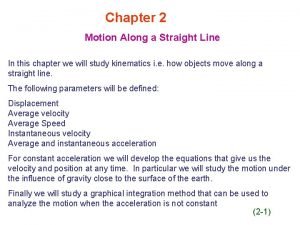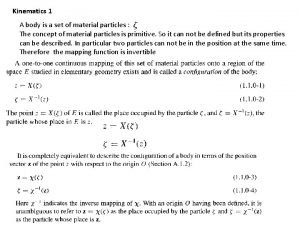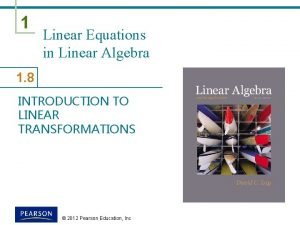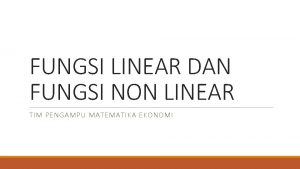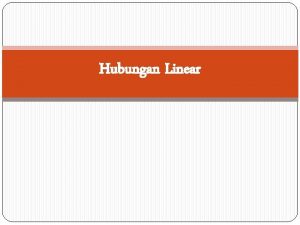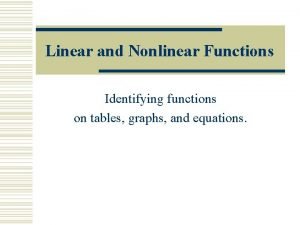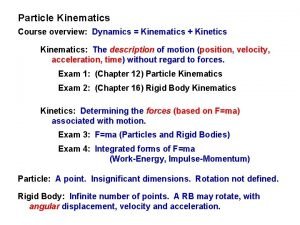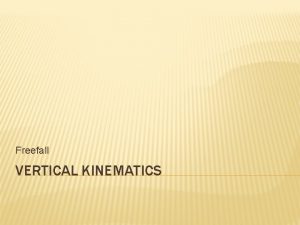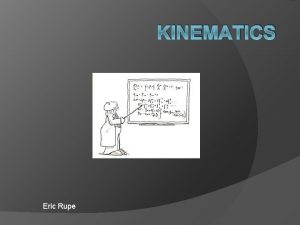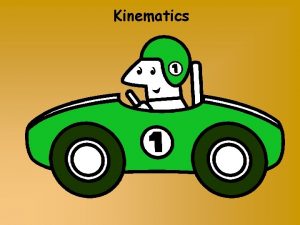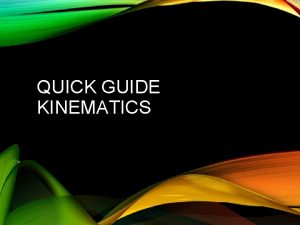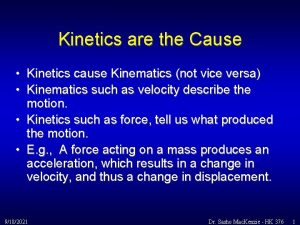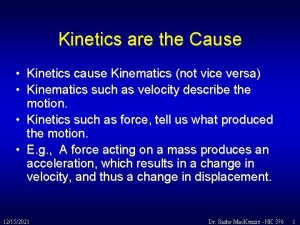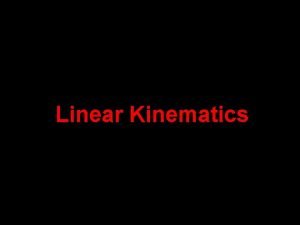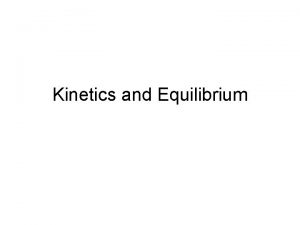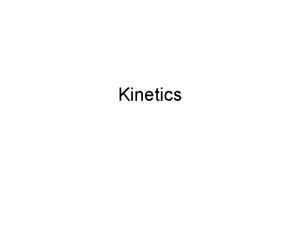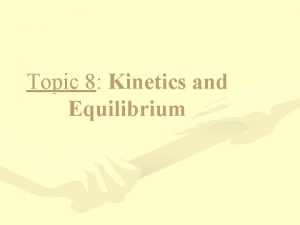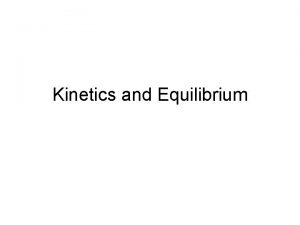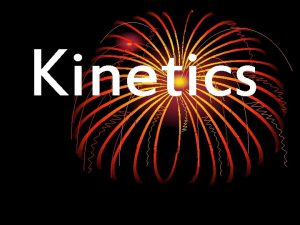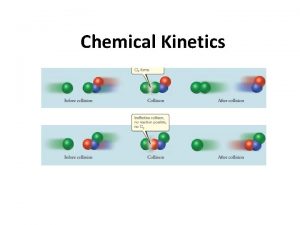Linear Kinetics Week 11 Kinematics Kinetics An understanding
































































































![Rate of change of the energy of a segment (power) [Ps] Muscle moment power Rate of change of the energy of a segment (power) [Ps] Muscle moment power](https://slidetodoc.com/presentation_image_h/30eb810aa405314a37221d4ccca8f1b9/image-97.jpg)








- Slides: 105

Linear Kinetics Week 11

Kinematics / Kinetics • An understanding of why humans move (kinematics) cannot be obtained if you do not understand kinetics (forces, torques and inertial properties)

FORCE is a push, pull, rub (friction), or blow (impact) causes or tends to cause motion or change in shape of a body • Usually drawn as an arrow indicating direction and magnitude.

Properties of Forces Magnitude Direction Point of application Line of application Angle of application

Mass • The quantity of matter contained in an • object. Units: kilograms Inertia • The tendency of a body to maintain a motionless state or a state of constant velocity. Proportional to mass.

Newton’s First Law “Every body continues in its state of rest or motion (constant velocity) in a straight line unless compelled to change that state by external forces exerted upon it. ” This relates to the concept of inertia.

Newton’s Second Law The rate of change of momentum of a body (or the acceleration for a body of constant mass) is proportional to the force causing it and the change takes place in the direction in which the force acts. It is in fact the “law of momentum


Mechanical Analysis Instantaneous Force F = ma Impulse – Momentum Ft = mv Work – Energy Fd = energy (linear kinetic, potential) rotational

Powerlifting (F=ma) Maximum Force Production. All joints simultaneously (not quite ……but the idea is mechanically correct

Throwing & Striking (Ft= mv) Use muscle joint systems in sequence

Many (most) movements are a combination

Newton’s Third Law ”For every force applied by one body on a second, the second body applies an equal and oppositely directed force on the first. ” “Law of action and reaction”

Non-Contact Forces The force of gravity is inversely proportional to the square of the distance between the centre of gravities of attracting objects and proportional to the product of their masses.

Weight The attractive force that the earth exerts on a body (the earth's gravitational pull). W = mg Units: Newtons!!? ? Acceleration due to Gravity The acceleration of a body due to the gravitational force of the earth is considered to be constant at -9. 81 m/s 2

Contact Forces Ground Reaction Force (GRF) Pressure Friction Fluid Resistance Elastic Force Muscle Force Joint Reaction Force

Momentum = mass x velocity The quantity of motion. NFL football running backs. Rugby forwards. Anthropometry.

Mechanical Impulse Examples: Generating velocity Trapping a soccer ball Protective equipment

Mechanical Impulse Effect of a force applied over a period of time Analysing human effort aimed at producing maximal velocity (maximal impulse) has been a focus of numerous studies However, the effect of different material in running shoes and other injury prevention issues can also be investigated by studying force-time profiles In the vertical jump example (numerical integration) we started with a force-time graph

Vertical Jump

Sample Problem Given the following approximate force profile (next slide) of a vertical jump from rest, calculate the subject’s take-off velocity. F = ma Mass of subject = 600 N Area of triangle = 0. 5 x base x height



Newton’s Third Law ”For every force applied by one body on a second, the second body applies an equal and oppositely directed force on the first. ” “Law of action and reaction”

Conservation of Momentum Following on from Newton’s law is the law of Conservation of Momentum. “In a system of bodies that exert forces on each other, the total momentum in any direction remains constant unless some external force acts on the system in that direction”.

Contact Forces The non-contact force of gravity already covered Ground Reaction Force (Pressure) Joint Reaction Force (already covered) Friction Fluid Resistance Muscle Force (already covered) Elastic Force

Force Platforms Force platforms are a sophisticated and expensive type of force transducer. Forces are calculated in x, y and z planes as are moments. Centre of pressure can also be calculated. Ground Reaction Force



Pressure (P = F/area) Force distribution is an important concept, especially in impact and other tissue loading situations.

Pressure Plots Pressure plots are essentially collected from a large number of small force transducers. Orthotic design is moving in this direction.

Foot Pressure Plots 3 -dimensional 2 -dimensional

Seat Pan Pressure Distribution 2 -dimensional 3 -dimensional

Backrest Comfort In addition to reducing pressure in the disk a good backrest should provide firm support across a wide area of the back (no pressure points). Opposite is a back rest pressure distribution

Force Transducers This is a pinch grip force transducer. A wide variety of force transducers are available. Simple strain gauge systems can also be very effective.

Magnitude of GRF Walking = 1 to 1. 2 x Body Weight Running = 3 to 5 x Body Weight (Hamill & Knutzen 1995) Squats = up to 7. 6 x Body Weight at patello-femoral joint (Reilly & Matens 1972) Hamill & Knutzen text has 7 graphs of GRF’s during different types of human movement (pages 400 -401).

Vertical Ground Reaction Force Time course of the GRF Impulse

GRF vs. Running Styles

Friction Force Friction is the force created between two contacting surfaces that tend to rub or slide past each other. Note: There can be friction without movement

Frictional Coefficients Coefficient of Friction = Static (max) Friction Sliding (kinetic) Friction Force Normal Force


Push or Pull?

Rolling Friction Coefficients of sliding and limiting friction are normally within a range of 0. 1 to 1. 0 Rolling friction is generally of a magnitude around 0. 001 (100 to 1000 times less than sliding and limiting friction Synovial fluid and articular cartilage? (0. 01 to 0. 003)

Inertial Force The force exerted due to the movement (inertia) of a body. Note a true force? Do not include on free body diagrams

Joint Force The muscles crossing a joint are not the only way forces are exerted on adjacent segments. In this case the shank is pushing the femur forwards and upwards

Elastic Force When a falling ball hits the ground the reaction force compresses it until its C of g stops its downward motion. The elastic recoil of the ball back to its round shape causes it to push against the ground, generating a ground reaction force that moves ball upwards.

Coefficient of Restitution "When two bodies undergo a direct collision, the difference between their velocities after impact is proportional to the difference between their velocities before impact. "

If one of the bodies is stationary (i. e impact with the floor).

Coefficient of Restitution Depends on: the nature of both contacting surfaces. the temperature of the surfaces. Also in non-uniform materials (e. g. baseball, golf ball) e may change with the speed of contact

Elastic Recoil Springboard diving, pole vault. Stretch-shortening cycle. Elastic recoil is important in locomotion (especially for kangaroos!)

Hysteresis Loops Hysteresis loops are basically force displacement curves The area between the two parts of the loop represent the energy lost.


Centripetal Forces Occurring Along a Curved Path If the car goes around the corner an external force must be exerted against it. You are forced in the same direction if wearing a seat belt.

Centripetal & Centrifugal Forces Whenever a body moves in a circular force it must be experiencing a force pushing or pulling it towards the centre of its path (axis). This Centripetal (centre seeking) force has an equal and opposite reaction (often called Centrifugal force although it is often inertial resistance). These forces are just special cases of an external force and the reaction force to that original force.

Centripetal & Centrifugal Forces Which comes first the Centrifugal or the Centripetal force? Sprinter running around curve? Hammer rotating around the thrower in the hammer throw? Cyclist negotiating a bend?

Magnitude of Centripetal Force Fc = mv 2/r Therefore, the centripetal force is higher if the mass and/or speed of the cyclist is increased and/or the radius of the curve is decreased

Why do Cyclists Lean into the Curve? This is not a situation of static equilibrium, why? However, if no rotation in the frontal plane is occurring, the net torque must equal zero. ΣΤ = 0

Sample Final Question? Leaning in towards the centre of rotation is common in many sports. Could you explain how these skaters do not fall inwards? What affects how much they have to lean

Why do we bank the track? If the track is not banked all of the centripetal force (reaction) must be obtained from friction. If the track is banked some of the centripetal force can be obtained via a normal ground reaction force (90 to frictional force) o

Mechanical Work, Energy and Power (segment models)

Work • Work is the product of force times the distance through which that force moves a load • Work = Force x distance • W=Fxd • W = F x d x cos θ • Units: Joules

Work • Work is a scalar • F x d => MLT-2 x L => ML 2 T-2 • As the L’s are the same, the square of them will always be positive • Torque is a vector • F x dperpendicular => MLT-2 x L • As the L’s are perpendicular to each other one could be positive the other negative, therefore torque has direction

Power = Δwork Δtime = (force) x Δdistance Δtime = force x velocity Units => Watts (J/s)

Energy Definition: “The ability to do work” Kinetic Energy = 1/2 mv 2 Gravitational Potential Energy = mgh (h is measured from the objects position to ground and therefore is negative, hence PE is positive) Elastic Strain Energy = 1/2 kx 2 Units => Joules

Units F x d => MLT-2 x L => ML 2 T-2 1/2 mv 2 => M(LT-1)2 => ML 2 T-2 mgh => MLT-2 x L => ML 2 T-2 What are the units of the spring constant in the equation for strain energy (1/2 kx 2)? MT-2

Conservation of Energy The total energy of a closed system is constant since energy does not enter or leave a closed system. This only occurs in human movement when the object is a projectile and we neglect air resistance. Then the total energy of the system (TE) = PE + KE. Note that gravity does not change the total energy of the system.


Work-Energy Relationship (staying with Linear Kinetics) • Work = total mechanical energy • Assuming we are studying a rigid body (one cannot store elastic energy), the equation becomes. • Fd = (1/2 mv 2 + mgh) • Fd = 1/2 mv 2 + mgh

Work-Energy Relationship This is not a new mechanical concept. It can be derived from Newton’s second law.

Work-Energy Relationship Kinetic Energy (horizontal

Work-Energy Relationship Angular Kinetics • If force is applied off centre (i. e. the line of action of the force vector does not pass through the centre of rotation of the body) then rotation as well as translation will occur.

Linear Force?

Translation

Eccentric Force?

Rotation and Translation

This is because: The centre of mass of a rigid body instantaneously accelerates in the direction of the applied resultant external force, irrespective of where the force is applied on the body. The rotational effect is also instantaneous. However, you do not get something for nothing

Rotation and Translation

slide from the Tennis Lecture

Back to the Vertical Jump • This is the same data from the problem 1 gave you earlier • Take-off velocity = 2. 534 m/s • Mass = 61. 2 kg • New question : If the jumper’s centre of gravity moved +0. 5 m vertically from the bottom of the drop down to the take of position, how much work did she do in this phase of the jump and what was her average force production?

Vertical Jump Power If you used body mass (61. 2 kg) instead of body weight (600 N) you should have calculated answer of 77. 3 kgm. s Where does the above equation come from? -1

Power = force x velocity From vf 2 = vi 2 + 2 ad we can calculate the velocity of take-off and, as we started from zero velocity, the average velocity during take-off.

Physiologists & Mechanical Units! You will come across a lot of physiology texts that report the power output from such tests in kg. m. s-1. This is not a unit of power. Without being too pedantic, I wonder why they cannot multiply the result by g (9. 81 m. s-2) to get the correct units of; kgm 2. s-3, or Joules/sec (J/s) or Watts. Fundamental units: ML 2 T-3

Bowflex Treadclimber • • • • “Reduce your workout time - dualmotion treadles let you step forward like a treadmill and up like a stair climber so you get more exercise in less time” “Tread. Climber® machine burns up to 2 TIMES more calories than a treadmill - at the same speed!” “Studies were conducted at the prestigious Human Performance Laboratory at New York's Adelphi University. The results were dramatic! In 22 separate trials, the Tread. Climber® machine burned up to 2 times more calories in 30 minutes than a treadmill at the same speed!” Company Website Sep-2006 http: //www. treadclimber. com/trc_microsite/fitnessbenefits. jsp

Work is Work (Power Output is…) Sure it is possible to burn twice the calories but ……………it would be twice as difficult TV commercial “burn twice the calories in one easymotion” “What do you get when you combine the best aerobic features of the stairclimber, treadmill, and elliptical trainer? Quite simply, you get a triple-charged cardioworkout “ Bowflex Website Sep-2006 Top Cross. Fit athletes ≅ 400 watts sustained for 2. min Approx equivalent to 80 RPM at 7. 5 kp (kg-Force) on a Monark Bike. (although using less muscle mass so it would be very difficult to generate that much power for that long on a bike. Wingate test (30 seconds maximal output) topperformers ≅ 700 Watts.

Next Slide The relationship of metabolic power produced in skeletal muscle to the mechanical power of activity. (Adapted from H. G. Knuttgen, Strength Training and Aerobic Exercise: Comparison and Contrast, Journal of Strength and Conditioning Research 21, no. 3 (2007): 973 -978. )


Olympic Lifting and Powerlifting Power Outputs Jerk ≈ 2, 140 W (56 kg) Jerk ≈ 4, 786 W (110 kg) Second pull Average power output from transition to maximum vertical velocity ≈ 5, 600 Watts (100 kg male); 2, 900 Watts (75 kg female). Peak power over a split second would be higher. Average Power (Powerlifting) • bench ≈ 300 W • squat ≈ 1, 000 W • deadlift ≈ 1, 100 W

Power to Weight Ratio In many sports it is not just about how much power you output …. it is also about how much you weight. For events like the Tour de France it is a matter of watts per kilogram of body weight, that is, the specific power output at lactate threshold - the amount of power/weight that the body can sustainably generate. It turns out that 6. 7 is more or less a magic number - the power/weight ratio required to win the TDF.

Energy/Power Analysis The previous is OK for a fitness test or an estimate of workr ate (power) during exercise. However, to calculate energy change (power) segment by segment we need to do a dynamic analysis. We need to take accelerations into account if the movement is too dynamic for a static analysis

Inverse Dynamic Analysis

Muscle Moment Power

Mechanical Work of Muscles

Mechanical Energy Transfer Between Segments Muscles can obviously do work on a segment (muscle moment power). However, if there is translational movement of the joints there is mechanical energy transfer between segments. (i. e. one segment does work on an adjacent segment by force displacement through the joint centre). Transfer of energy is very important in improving the overall efficiency of human movement patterns.

Joint Force Power


Human Energy Harvesting Biomechanical Energy Harvesting: Generating Electricity During Walking with Minimal User Effort J. M. Donelan, 1* Q. Li, 1 V. Naing, 1 J. A. Hoffer, 1 D. J. Weber, 2 A. D. Kuo 3 Science 8 February 2008: Vol. 319. no. 5864, pp. 807 - 810
![Rate of change of the energy of a segment power Ps Muscle moment power Rate of change of the energy of a segment (power) [Ps] Muscle moment power](https://slidetodoc.com/presentation_image_h/30eb810aa405314a37221d4ccca8f1b9/image-97.jpg)
Rate of change of the energy of a segment (power) [Ps] Muscle moment power for the proximal joint Muscle moment power for the distal joint Joint force power for the proximal joint Joint force power for the distal joint Ps = Mpω +Mdω +Fpvp+Fdvd

Total Instantaneous Energy of a Body • ET = 2 1/2 mv + mgh + 2 1/2 Iω


Efficiency Metabolic efficiency is a measure of the muscles ability to convert metabolic energy to tension. A high metabolic efficiency does not necessarily mean that an efficient movement is taking place (e. g. cerebral palsy). The ability of the central nervous system to control the tension patterns is what influences the mechanical efficiency.

Overall Muscular Efficiency Muscular Eff. = Net mechanical work Net metabolic energy Net mechanical work = Internal work + External work Internal work: Work done by muscles in moving body segments. External work: Work done by muscles to move external masses or work against external resistance. Aprrox. 20 -25% efficiency.

Contraction time related to force - velocity curve

Efficiency All efficiency calculations involve some measure of mechanical output divided by a measure of metabolic input. Metabolic work is not too difficult to estimate we do gas analysis. External work also easy to calculate. But we need to calculate internal mechanical work. Clearly we must at least calculate absolute energy changes (negative work is still an energy cost to the body). However, isometric contractions against gravity still a problem.

Causes of Inefficient Movement Co-contraction Isometric Contractions Against Gravity Example of hands out straight. No mechanical work being done! Jerky Movements high accelerations & decelerations waste energy compared to gradual acceleration Generation of energy at one joint and absorption at another (walking example) Joint friction (small)

 Aplusphysics kinematics-horizontal kinematics
Aplusphysics kinematics-horizontal kinematics Planar kinematics of a rigid body
Planar kinematics of a rigid body Linear kinematics examples
Linear kinematics examples Linear and angular kinematics
Linear and angular kinematics Week by week plans for documenting children's development
Week by week plans for documenting children's development Kinematics of simple harmonic motion
Kinematics of simple harmonic motion General physics equations
General physics equations Dynamics kinematics
Dynamics kinematics Describing motion kinematics in one dimension
Describing motion kinematics in one dimension Forward kinematics
Forward kinematics Iczv
Iczv Forward kinematics
Forward kinematics Kinematics
Kinematics Rectilinear kinematics continuous motion
Rectilinear kinematics continuous motion Kinematics of a particle moving in a straight line answers
Kinematics of a particle moving in a straight line answers Introduction of kinematics
Introduction of kinematics Uniformly accelerated motion formula
Uniformly accelerated motion formula Angular kinematics biomechanics
Angular kinematics biomechanics Two dimensional kinematics equations
Two dimensional kinematics equations Open kinetic chain exercises
Open kinetic chain exercises Dynamics vs kinematics
Dynamics vs kinematics Variable acceleration definition
Variable acceleration definition Tempus
Tempus In her physics lab melanie rolls
In her physics lab melanie rolls Kinematic equaitons
Kinematic equaitons Coriolis acceleration kinematics
Coriolis acceleration kinematics Inverse kinematics
Inverse kinematics Kinematics of a particle
Kinematics of a particle 3 body decay
3 body decay One dimensional kinematics problems
One dimensional kinematics problems Forward kinematics
Forward kinematics General planar motion
General planar motion Kinematics
Kinematics Holonomic drive
Holonomic drive 1 dimensional kinematics
1 dimensional kinematics Robot coordinate system
Robot coordinate system Rectilinear kinematics: continuous motion
Rectilinear kinematics: continuous motion Kinematic equations examples
Kinematic equations examples Graphic statics
Graphic statics Kinematics
Kinematics Suvat equations a level
Suvat equations a level Kinematics equations for uniformly accelerated motion
Kinematics equations for uniformly accelerated motion Kinematics and dynamics of machines
Kinematics and dynamics of machines Planar rigid body
Planar rigid body Fluid kinematics ppt
Fluid kinematics ppt Rotational kinematics
Rotational kinematics Erratic motion examples with solutions
Erratic motion examples with solutions Kinematics
Kinematics Jacobian singularity
Jacobian singularity Kinematics of a particle
Kinematics of a particle Arnold kennedy theorem
Arnold kennedy theorem Kinematics-defining motion
Kinematics-defining motion Dynamics rigid body kinematics
Dynamics rigid body kinematics Kinematics definition
Kinematics definition Aplusphysics kinematics-free fall
Aplusphysics kinematics-free fall Kinematics
Kinematics Projectile motion formula
Projectile motion formula Range motion
Range motion Tricycle kinematics
Tricycle kinematics Body kinematics
Body kinematics Fluid kinematics is part of fluid mechanics in which
Fluid kinematics is part of fluid mechanics in which Kinematic equation for instantaneous velocity
Kinematic equation for instantaneous velocity What is motion along a straight line
What is motion along a straight line Kinematics ib physics
Kinematics ib physics Where is the station?
Where is the station? Final velocity formula
Final velocity formula Dh convention
Dh convention Magnitude of angular acceleration formula
Magnitude of angular acceleration formula Rotational equations
Rotational equations Kinetics of rigid bodies
Kinetics of rigid bodies Describing motion kinematics in one dimension
Describing motion kinematics in one dimension Kinematics ppt
Kinematics ppt Rotational kinematics
Rotational kinematics Rrt
Rrt Spherical wrist robot
Spherical wrist robot Kinematics of a particle
Kinematics of a particle A level physics kinematics
A level physics kinematics Kinematics robot
Kinematics robot Dr frost further kinematics
Dr frost further kinematics Inverse kinematics
Inverse kinematics Angular acceleration
Angular acceleration Poe final exam review
Poe final exam review What is kinematics
What is kinematics Vertical
Vertical Kinematics ppt
Kinematics ppt Motion along the straight line
Motion along the straight line Transport theorem kinematics
Transport theorem kinematics Simple linear regression and multiple linear regression
Simple linear regression and multiple linear regression Nonlinear plot structure examples
Nonlinear plot structure examples Graphical method simultaneous equations
Graphical method simultaneous equations A left linear grammar is always
A left linear grammar is always O que seria um texto narrativo
O que seria um texto narrativo Linear algebra linear transformation
Linear algebra linear transformation Contoh persamaan non linier
Contoh persamaan non linier Persamaan non linier metode biseksi
Persamaan non linier metode biseksi Linear vs nonlinear equations
Linear vs nonlinear equations Linear editing vs non linear editing
Linear editing vs non linear editing Perbedaan fungsi linear dan non linear
Perbedaan fungsi linear dan non linear Dwi koordinat
Dwi koordinat Linear pipeline
Linear pipeline Non linear text
Non linear text How to solve non linear simultaneous equations
How to solve non linear simultaneous equations Linear or non linear
Linear or non linear Perbedaan fungsi linier dan non linier
Perbedaan fungsi linier dan non linier Linear impulse
Linear impulse Linear and non linear multimedia
Linear and non linear multimedia

